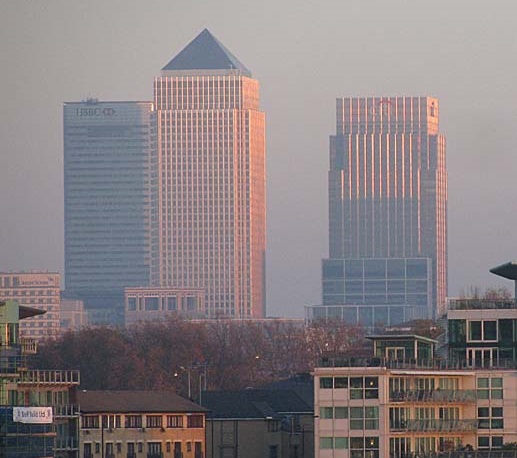One Canada Square
One Canada Square, commonly referred to as Canary Wharf Tower, is a skyscraper located in the London’s Docklands area known as Canary Wharf. With a height of 235 m (770 ft), it is currently (2018) the second tallest building in the United Kingdom. It is predominantly used for offices, although there are a number of retail units on the lower ground floor.
Designed by Cesar Pelli, Adamson Associates and Frederick Gibberd Coombes in the postmodern style, the building takes the form of an obelisk; a tower that is square in plan and topped with a pyramid.
Construction began in 1988, and upon completion in 1991 it was the tallest building in Europe and remained the UK’s tallest building for 20 years, helping to transform the previously derelict Isle of Dogs into a successful financial district.
The developers originally intended to clad the 50-storey tower in stone, but this was later changed to low density aluminium, before settling on stainless steel with a linen finish. It was the first skyscraper to have been constructed with stainless steel. In total, approximately 27,500 tonnes of British steel were used.
The construction involved building a large cofferdam to prevent water leakage into the site, and 222 piles were driven into the ground to depths of 23 m. A 4 m-thick concrete raft was sunk into the ground to act as an anchor.
The core of the building includes a tuned mass damper – a steel pendulum – that sways to offset movements caused by strong winds.
The stainless steel pyramidal roof, measuring 30 sq. m at its base, encloses maintenance plant and other facilities for water supply, as well as a warning beacon for aircraft travelling to and from the nearby London City Airport.
The building is regularly used on TV and for films, making it one of the most recognisable buildings in the UK.
[edit] Related articles on Designing Buildings Wiki
Featured articles and news
Gregor Harvie argues that AI is state-sanctioned theft of IP.
Many resources for visitors aswell as new features for members.
Using technology to empower communities
The Community data platform; capturing the DNA of a place and fostering participation, for better design.
Heat pump and wind turbine sound calculations for PDRs
MCS publish updated sound calculation standards for permitted development installations.
Homes England creates largest housing-led site in the North
Successful, 34 hectare land acquisition with the residential allocation now completed.
Scottish apprenticeship training proposals
General support although better accountability and transparency is sought.
The history of building regulations
A story of belated action in response to crisis.
Moisture, fire safety and emerging trends in living walls
How wet is your wall?
Current policy explained and newly published consultation by the UK and Welsh Governments.
British architecture 1919–39. Book review.
Conservation of listed prefabs in Moseley.
Energy industry calls for urgent reform.
Heritage staff wellbeing at work survey.
A five minute introduction.
50th Golden anniversary ECA Edmundson apprentice award
Showcasing the very best electrotechnical and engineering services for half a century.
Welsh government consults on HRBs and reg changes
Seeking feedback on a new regulatory regime and a broad range of issues.
CIOB Client Guide (2nd edition) March 2025
Free download covering statutory dutyholder roles under the Building Safety Act and much more.
























